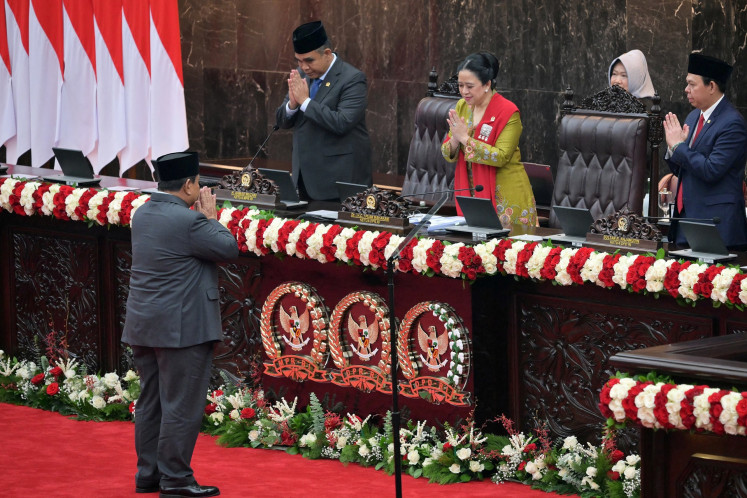Popular Reads
Top Results
Can't find what you're looking for?
View all search resultsPopular Reads
Top Results
Can't find what you're looking for?
View all search resultsLiba follows her heart
Inside Libaâs apartment in Paris, which is richly decorated with Indonesian artifacts and Indonesian-made furniture
Change text size
Gift Premium Articles
to Anyone
 Inside Libaâs apartment in Paris, which is richly decorated with Indonesian artifacts and Indonesian-made furniture. (JP/Cynthia Webb)" border="0" height="341" width="512">Inside Libaâs apartment in Paris, which is richly decorated with Indonesian artifacts and Indonesian-made furniture. (JP/Cynthia Webb)
Inside Libaâs apartment in Paris, which is richly decorated with Indonesian artifacts and Indonesian-made furniture. (JP/Cynthia Webb)" border="0" height="341" width="512">Inside Libaâs apartment in Paris, which is richly decorated with Indonesian artifacts and Indonesian-made furniture. (JP/Cynthia Webb)If life were a fruit, then Liba Waring Stambollion is a woman who knows how to extract every drop of its precious juice.
The woman â an artist, poet, book maker, publisher and furniture designer â explores her Asian influences in her works.
âI am very influenced by Indonesia and the furniture I design is a mix of East and West,â said Liba, as she is known among her friends.
The woman, who first started doing formal business in Indonesia in 1991, has visited Indonesia almost every year since 1973, when Kuta in Bali was still a fishing village.
âI went there to buy masks and puppets, which a friend and I sold at street fairs in Chicago,â said Liba.
Born in the US on Aug. 1, 1963, her family lived in Southeast Asia from when Liba was two years old.
Her parents moved to Singapore, where they lived for three years before moving to the Philippines. There was some time spent in Hong Kong and then they moved to Jakarta, where Liba attended the Joint Embassy School (JES) for several years.
 PC Board collectors. It is a limited series made from old PC boards dating from 1960s to today designed by L. Gensollen.
PC Board collectors. It is a limited series made from old PC boards dating from 1960s to today designed by L. Gensollen.
Through the years, she learned âdecent Indonesianâ, adding it to the Cantonese, Mandarin and Tagalog that sheâd already been exposed to.
Her father was a Harvard educated banker and her mother was an artist, who had also grown up all over the world because her father was Rear Admiral of the US Navy.
When the family moved back to the US in 1976, Liba, then aged 13, went into culture shock. She expressed it by becoming a rebellious teenager, leaving home very early and finally joining the counter-culture movement.
Aged fifteen, at a protest in the Black Hills of Dakota, she experienced a kind of spiritual epiphany, which gave her life its meaning and momentum.
For a couple of years Liba hitchhiked around the country attending summer festivals, fell in love, and gave birth to her first son, Jariah. But the relationship faltered and when she was 21 and Liba moved to Chicago where she gained a scholarship to attend the Art Institute of Chicago.
At the institute, she spent âan absolutely amazing four yearsâ studying bookbinding, bookmaking, woodworking and painting.
 Teak and bamboo cabinet with laundry basket. (Courtesy of Matahati)
Teak and bamboo cabinet with laundry basket. (Courtesy of Matahati)
After graduating, she taught art for four years and also worked for a cabinet maker learning her furniture design skills.
In Chicago she met Frenchman, Pascal Stambollion, who was studying at the Kellogg Business School.
âWe decided to marry, but first we took a six month trip to Central Asia,â Liba explained.
Since January of 1993, the couple has lived in Paris and another son Raphael was born in 1995.
Looking at their Matahati exotic furniture showroom, located at the 26 rue St. Ambroise, it is evident that the designs by both Liba and Pascal are very different from what is usually on offer in Paris.
The pieces are practical and the forms are very elegant, simple, with a look of refinement. Materials used are renewable or recycled, while the tones and textures that decorate the pieces are all nature-based.
Labor-intensive techniques, such as oyster shell inlay, bamboo and coconut inlays, almond shells, cinnamon wood and carving, are used and the skill and patience of Indonesian craft workers astounds the buyers.
Ahmad Husen, who is based in Yogyakarta, is Liba and Pascalâs business partner and long time friend, who has set up a community based system, where work is distributed to a network of village workshops.
âIt gives employment to many people and keeps the money circulating away from the center,â Liba says.
Matahati, which literally translates into the eye of the heart, began as a wholesale outlet and because the tropical and exotic look was so new, within a year their Indonesian made furniture items were featured on TV and in leading journals, such as Le Monde and Figaro.
âWe got big, really quickly,â said Liba. âWe were doing pieces for royalty, rock stars, film stars and some of the best department stores in the world, including the famous Bon Marche.â
Then, the fateful day, 9/11, hit. This caused a sudden financial downturn and they were caught with a big business organization and a lot of expenses. In order to avoid financial catastrophe they decided to become retailers.
span class="caption" style="width: 510px;">Inside Liba's apartment in Paris, which is richly decorated with Indonesian artifacts and Indonesian-made furniture. (JP/Cynthia Webb) If life were a fruit, then Liba Waring Stambollion is a woman who knows how to extract every drop of its precious juice. PC Board collectors. It is a limited series made from old PC boards dating from 1960s to today designed by L. Gensollen. Teak and bamboo cabinet with laundry basket. (Courtesy of Matahati) Then, the fateful day, 9/11, hit. This caused a sudden financial downturn and they were caught with a big business organization and a lot of expenses. In order to avoid financial catastrophe they decided to become retailers. Liba poses with one of her paintings framed in a Javanese antique bird perch. (JP/Cynthia Webb)
I
The woman ' an artist, poet, book maker, publisher and furniture designer ' explores her Asian influences in her works.
'I am very influenced by Indonesia and the furniture I design is a mix of East and West,' said Liba, as she is known among her friends.
The woman, who first started doing formal business in Indonesia in 1991, has visited Indonesia almost every year since 1973, when Kuta in Bali was still a fishing village.
'I went there to buy masks and puppets, which a friend and I sold at street fairs in Chicago,' said Liba.
Born in the US on Aug. 1, 1963, her family lived in Southeast Asia from when Liba was two years old.
Her parents moved to Singapore, where they lived for three years before moving to the Philippines. There was some time spent in Hong Kong and then they moved to Jakarta, where Liba attended the Joint Embassy School (JES) for several years.
Through the years, she learned 'decent Indonesian', adding it to the Cantonese, Mandarin and Tagalog that she'd already been exposed to.
Her father was a Harvard educated banker and her mother was an artist, who had also grown up all over the world because her father was Rear Admiral of the US Navy.
When the family moved back to the US in 1976, Liba, then aged 13, went into culture shock. She expressed it by becoming a rebellious teenager, leaving home very early and finally joining the counter-culture movement.
Aged fifteen, at a protest in the Black Hills of Dakota, she experienced a kind of spiritual epiphany, which gave her life its meaning and momentum.
For a couple of years Liba hitchhiked around the country attending summer festivals, fell in love, and gave birth to her first son, Jariah. But the relationship faltered and when she was 21 and Liba moved to Chicago where she gained a scholarship to attend the Art Institute of Chicago.
At the institute, she spent 'an absolutely amazing four years' studying bookbinding, bookmaking, woodworking and painting.
After graduating, she taught art for four years and also worked for a cabinet maker learning her furniture design skills.
In Chicago she met Frenchman, Pascal Stambollion, who was studying at the Kellogg Business School.
'We decided to marry, but first we took a six month trip to Central Asia,' Liba explained.
Since January of 1993, the couple has lived in Paris and another son Raphael was born in 1995.
Looking at their Matahati exotic furniture showroom, located at the 26 rue St. Ambroise, it is evident that the designs by both Liba and Pascal are very different from what is usually on offer in Paris.
The pieces are practical and the forms are very elegant, simple, with a look of refinement. Materials used are renewable or recycled, while the tones and textures that decorate the pieces are all nature-based.
Labor-intensive techniques, such as oyster shell inlay, bamboo and coconut inlays, almond shells, cinnamon wood and carving, are used and the skill and patience of Indonesian craft workers astounds the buyers.
Ahmad Husen, who is based in Yogyakarta, is Liba and Pascal's business partner and long time friend, who has set up a community based system, where work is distributed to a network of village workshops.
'It gives employment to many people and keeps the money circulating away from the center,' Liba says.
Matahati, which literally translates into the eye of the heart, began as a wholesale outlet and because the tropical and exotic look was so new, within a year their Indonesian made furniture items were featured on TV and in leading journals, such as Le Monde and Figaro.
'We got big, really quickly,' said Liba. 'We were doing pieces for royalty, rock stars, film stars and some of the best department stores in the world, including the famous Bon Marche.'
In the last few years, Liba has at last been able to get back to her painting, inspired by her lucid dreaming.
She is currently working on a series of ecology themed paintings of wild creatures, which are depicted within frames which are actually very attractive traditional bird perches that she seeks out in Java.
Pascal is working on a novel about Indonesia, featuring politics and magic.
Liba's latest project, Dreams & Divinities, is a community based, non-profit 'heart consciousness project', which creates both structures for artist collaborations and showcases the work.
The project has so far published two limited edition art books. The first one was called Sacred Visions from Women, which included work from 13 international painters and eight poets.
Her second book Divining the Dream includes 61 male and female artists along with 26 poets. Indonesian artist Wayan Sika of Bali is featured in it.
Now she's busy with another project as a result of the second art book. There was a linked art show of the works that went to four cities in Spain and two cities in France. The exhibition has now been invited to Mexico. It will open on Spring Equinox, March 21 next year,in San Cristobal.
'There is no funding and we are supported by volunteers and people offering us spaces,' said Liba, amazed that this project too, has its own heart energy.
'It seems that love is a binding quality that we can all agree on.'
Your Opinion Matters
Share your experiences, suggestions, and any issues you've encountered on The Jakarta Post. We're here to listen.
Thank You
Thank you for sharing your thoughts. We appreciate your feedback.
Share options
Quickly share this news with your network—keep everyone informed with just a single click!
Gift Premium Articles
to Anyone
Share the best of The Jakarta Post with friends, family, or colleagues. As a subscriber, you can gift 3 to 5 articles each month that anyone can read—no subscription needed!
Continue in the app
Get the best experience—faster access, exclusive features, and a seamless way to stay updated.









